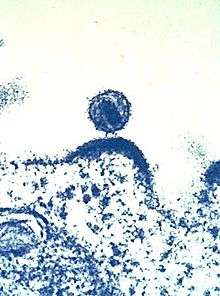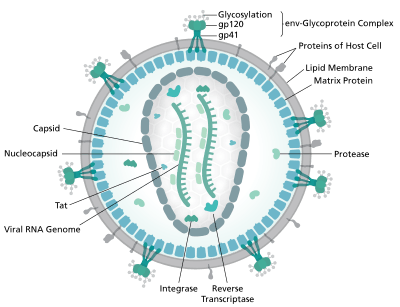Wesley Sundquist
Wesley Sundquist (born 1959) is an American chemists and biochemist. Sundquist is known for studying the cellular, molecular and structurally biology of retroviruses, particularly HIV. He is also known for studying the ESCRT pathway in cell division.[1]
Life and education

Wesley Sundquist was born in St. Paul, Minnesota in 1959. He grew up in St. Paul Minnesota and Washington, DC. He received his bachelor’s degree in Chemistry from Carleton College in Minnesota in 1981. At his time at Carleton Sundquist served as the coordinator of the Faribault Project, was elected to Sigma Xi and enrolled in the National Merit Scholars program 1977 and 1981. Sundquist went on to complete a PhD at the Massachusetts Institute of Technology in 1988. Following his PhD, he went on to participate in postdoctoral research at the MRC Laboratory of Molecular in Cambridge, England under Sir Aaron Klug. In 1992 Sundquist joined the University of Utah biochemistry department.[2] Sundquist is married to Nola Sundquist and has two children whom he lives with in Salt Lake City, Utah.
Work and discoveries

In addition to being the Co-chair for the Department of Biology at the University of Utah, he is a member of the Cell Response and Regulation Program at Huntsman Institute.[1] He also runs Biochemistry Sundquist Labs. Sundquist Labs focuses on cellular, molecular and structural biology of retroviruses with a key spotlight on Human Immunodeficiency Virus, HIV. Major projects in the lab include, 1) enveloped virus assembly 2) ESCRT pathway functions and regulation in cell division and cancer, and 3) HIV capsid structure, replication and restriction.[3]
Enveloped virus assembly
In order for HIV to spread, it must be enveloped. Retroviruses like HIV bud from the host using the Endosomal Sorting Pathway Required for Transport or ESCRT. In addition to this pathway, HIV also uses the host proteins of the Angiomotin family in facilitating membrane envelopment before ESCRT- mediated budding can occur. Sundquist's primary research in this area focuses on understanding assembly and budding of HIV, characterizing the proteins involved and testing restriction of viruses using the ESCRT due to our innate immune proteins.
Selected publications
- von Schwedler, Uta K.; Stray, Kirsten M.; Garrus, Jennifer E.; Sundquist, Wesley I. (2003). "Functional Surfaces of the Human Immunodeficiency Virus Type 1 Capsid Protein". Journal of Virology. 77 (9): 5439–5450. doi:10.1128/jvi.77.9.5439-5450.2003. PMC 153941. PMID 12692245.
- Ganser, B. K. (2003). "Three-dimensional structure of the M-MuLV CA protein on a lipid monolayer: A general model for retroviral capsid assembly". The EMBO Journal. 22 (12): 2886–2892. doi:10.1093/emboj/cdg276. PMC 162131. PMID 12805204.
- Lamorte, Louie; Titolo, Steve; Lemke, Christopher T.; Goudreau, Nathalie; Mercier, Jean-François; Wardrop, Elizabeth; Shah, Vaibhav B.; von Schwedler, Uta K.; Langelier, Charles; Banik, Soma S. R.; Aiken, Christopher; Sundquist, Wesley I.; Mason, Stephen W. (2013). "Discovery of Novel Small-Molecule HIV-1 Replication Inhibitors That Stabilize Capsid Complexes". Antimicrobial Agents and Chemotherapy. 57 (10): 4622–4631. doi:10.1128/AAC.00985-13. PMC 3811413. PMID 23817385.
- Mercenne, Gaelle; Alam, Steven L.; Arii, Jun; Lalonde, Matthew S.; Sundquist, Wesley I. (2015). "Angiomotin functions in HIV-1 assembly and budding". eLife. 4. doi:10.7554/eLife.03778. PMC 4337731. PMID 25633977.
ESCRT pathway functions in cell division
Multi-vesicular body biogenesis, neuronal pruning, reassembly of the post-mitotic nuclear envelope and final stage cell division are all catalyzed through the ESCRT pathway. Cytokinetic abscission helps to coordinate the checkpoint which delays completion of the final stage cell division until mitotic processes are complete. The ERSCT pathway mediates the recruiting and organizing of this final mechanical step of abscission. Within cancer cells, the function of this pathway doesn’t function correctly. In studying this, Sundquist’s labs are determining the structures and functions associated with the filaments and the proteins they recruit as well as their enzymatic activity in the ESCRT pathway. Signaling pathways that control the checkpoint and ESCRT pathway are also explored.
Selected publications
- Scott, A.; Gaspar, J.; Stuchell-Brereton, M. D.; Alam, S. L.; Skalicky, J. J.; Sundquist, W. I. (2005). "Structure and ESCRT-III protein interactions of the MIT domain of human VPS4A". Proceedings of the National Academy of Sciences. 102 (39): 13813–13818. Bibcode:2005PNAS..10213813S. doi:10.1073/pnas.0502165102. PMC 1236530. PMID 16174732.
- Langelier, Charles; von Schwedler, Uta K.; Fisher, Robert D.; De Domenico, Ivana; White, Paul L.; Hill, Christopher P.; Kaplan, Jerry; Ward, Diane; Sundquist, Wesley I. (2006). "Human ESCRT-II Complex and Its Role in Human Immunodeficiency Virus Type 1 Release". Journal of Virology. 80 (19): 9465–9480. doi:10.1128/JVI.01049-06. PMC 1617254. PMID 16973552.
- Kieffer, Collin; Skalicky, Jack J.; Morita, Eiji; De Domenico, Ivana; Ward, Diane M.; Kaplan, Jerry; Sundquist, Wesley I. (2008). "Two Distinct Modes of ESCRT-III Recognition Are Required for VPS4 Functions in Lysosomal Protein Targeting and HIV-1 Budding". Developmental Cell. 15 (1): 62–73. doi:10.1016/j.devcel.2008.05.014. PMC 2586299. PMID 18606141.
- McCullough, J.; Clippinger, A. K.; Talledge, N.; Skowyra, M. L.; Saunders, M. G.; Naismith, T. V.; Colf, L. A.; Afonine, P.; Arthur, C.; Sundquist, W. I.; Hanson, P. I.; Frost, A. (2015). "Structure and membrane remodeling activity of ESCRT-III helical polymers". Science. 350 (6267): 1548–1551. Bibcode:2015Sci...350.1548M. doi:10.1126/science.aad8305. PMC 4684769. PMID 26634441.
HIV replication and restriction

The capsid of HIV facilitates the reverse transcription required to spread throughout the host as well as protect the viral genome from the innate immune system. Sundquist defined the host restriction factor, TRIM5a, which recognizes and assembles around the capsid. Furthering this finding, Sundquist Lab is looking into exactly how the capsid promotes this reverse transcription and how TRIM5a binding in the host can inhibit this.
Selected publications
- Fletcher, Adam J.; Christensen, Devin E.; Nelson, Chad; Tan, Choon Ping; Schaller, Torsten; Lehner, Paul J.; Sundquist, Wesley I.; Towers, Greg J. (2015). "TRIM 5α requires Ube2W to anchor Lys63‐linked ubiquitin chains and restrict reverse transcription". The EMBO Journal. 34 (15): 2078–2095. doi:10.15252/embj.201490361. PMC 4551353. PMID 26101372.
- Li, Yen-Li; Chandrasekaran, Viswanathan; Carter, Stephen D.; Woodward, Cora L.; Christensen, Devin E.; Dryden, Kelly A.; Pornillos, Owen; Yeager, Mark; Ganser-Pornillos, Barbie K.; Jensen, Grant J.; Sundquist, Wesley I. (2016). "Primate TRIM5 proteins form hexagonal nets on HIV-1 capsids". eLife. 5. doi:10.7554/eLife.16269. PMC 4936896. PMID 27253068.
- Wagner, Jonathan M.; Christensen, Devin E.; Bhattacharya, Akash; Dawidziak, Daria M.; Roganowicz, Marcin D.; Wan, Yueping; Pumroy, Ruth A.; Demeler, Borries; Ivanov, Dmitri N.; Ganser-Pornillos, Barbie K.; Sundquist, Wesley I.; Pornillos, Owen (2017). "A general model for retroviral capsid pattern recognition by TRIM5 proteins". Journal of Virology. 92 (4): JVI.01563–17. doi:10.1128/JVI.01563-17. PMC 5790955. PMID 29187540.
- Sundquist, Wesley I.; Pornillos, Owen (2018). "Retrovirus Restriction by TRIM5α: RINGside at a Cage Fight". Cell Host & Microbe. 24 (6): 751–753. doi:10.1016/j.chom.2018.11.013. PMC 6464375. PMID 30543772.
Honors and scientific legacy
In 1993 Sundquist received the Searle Scholars Award.
He also received the ASBMB Amgen Award for the Application of Biochemistry and Molecular Biology to the understanding of disease in 2003.
In 2004 he received both the MERIT award from the National Institutes of Health and the Bernard Fields award for Retrovirology. He is also a member of the National Academy of Sciences.[2]
References
- "Members - U of U School of Medicine - | University of Utah". medicine.utah.edu. Retrieved 2020-04-08.
- "Wesley I. Sundquist '81 | Class of 1981 | Carleton College". apps.carleton.edu. Retrieved 2020-04-08.
- "Research - | University of Utah". medicine.utah.edu. Archived from the original on 2020-02-11. Retrieved 2020-04-08.